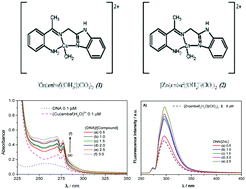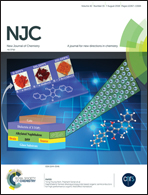Comparative studies of Schiff base-copper(ii) and zinc(ii) complexes regarding their DNA binding ability and cytotoxicity against sarcoma cells
Abstract
A series of Schiff base (ambaf, apyapn and apyepy) copper(II) (1, 3, 5 and 6) and analogous zinc(II) (2 and 4) complexes were synthesized, and characterized by spectroscopic techniques (IR, UV/Vis, RMN, EPR), in addition to elemental and mass spectrometry (ESI-MS) analyses. The ligands, ambaf = 2-[N-(1H-benzimidazol-2-ylmethyl)ethanimidoyl]aniline, apyapn = N-[1-(pyridin-2-yl)ethylidene]-N′-(2-{[1-(pyridin-2-yl)ethylidene]amino}ethyl)propane-1,3-diamine and apyepy = 2-(pyridin-2-yl)-N-[1-(pyridin-2-yl)ethylidene]ethanamine, were obtained from 2-acetylpyridine in condensation reactions with the corresponding amines. Most of the complexes were isolated with the metal ion coordinated to tridentate ligands, the fourth position being occupied by a labile ligand, a water or a hydroxide anion. Studies of the interaction of these complexes with calf thymus–DNA by circular dichroism (CD) and UV/Vis spectroscopies indicated high intrinsic binding constants (Kb) in the range of 104 to 107 M−1. These studies indicated that all the compounds are capable of interacting with DNA, via intercalation between the base pairs, or electrostatically with the DNA phosphate groups. Their cytotoxicity was then tested against human sarcoma cancer cells (MES-SA and MES-SA/Dx5), in comparison to non-tumorigenic fibroblasts (P4), and the results showed a moderate toxicity for most of them, in the range of 40 to 70 μM, in good correlation with their cellular metal uptake. The observed order of reactivity is also dependent on the ligand features as well as on the nature of the metal ion, and the geometric configuration around it. The zinc(II) complex 2 containing a benzimidazole moiety was unexpectedly more cytotoxic than the analogous copper(II) complex 1, probably due to its additional photo-reactivity.



 Please wait while we load your content...
Please wait while we load your content...